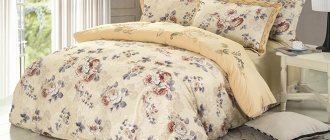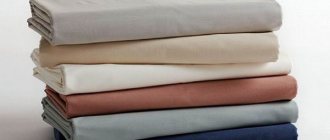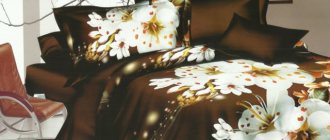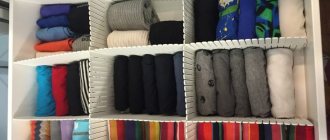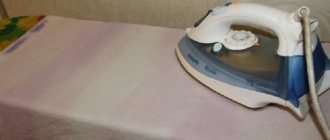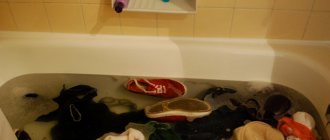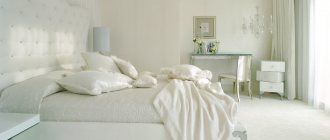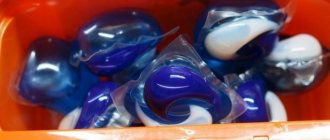The world of fabrics is diverse. Manufacturers offer a huge number of new types. But, for many centuries, there have been traditional and popular ones that will never go out of use. These include percale and satin. They are still relevant today, thanks to their qualities and positive characteristics.
Many, not knowing the qualities of matter, are lost when choosing. Which one is better and what are the differences? Even professional seamstresses find it difficult to understand these materials.
Percale or satin - which is better and why
Most often, bed linen is made from these fabrics. Percale is so dense and durable that it is used for sewing tents, flags, and sails for ships.
Seamstresses love to use percale for sewing bed linen and pillow covers. Due to its dense structure, the material does not allow feathers to escape from the pillowcase. It is comfortable to sleep on such linen. On hot days it cools the body, and on cold days it warms the body.
Satin is also woven from natural cotton. They use a complex weaving pattern. The result is a shiny and soft fabric. At the same time, the front side is glossy and the back side is matte. Bed linen is also made from satin.
Which one is better to choose from these fabrics? Depends on consumer preferences.
Conclusion
If you want to buy high-quality bedding, you will have to choose between the two most expensive and durable materials. Percale or satin – it’s not so easy to decide.
These are the most dense and wear-resistant materials. But due to the way it is created, percale can withstand five times as many washes. Satin is more attractive in appearance - because of its smoothness and shine, it resembles silk. At the same time, the cost of satin, although slightly, is higher than the cost of percale. But the latter is more difficult to care for.
However, the main criterion remains personal preference. After all, satin is a smooth and sliding material, while percale is rough and velvety.
What is the difference between satin and percale?
Both types of fabrics are made from high quality cotton. They are very durable. Retains colors well after washing. But there are still differences:
- In terms of strength, percale is the leader. Withstands a greater number of washes - up to a thousand; Therefore, it will last longer. Satin is much softer and thinner. Therefore, it loses its qualities faster. It can only withstand up to three hundred washes. It may lose color and fade.
- There are also differences in the texture of the fabric. Percale is soft, with a velvety surface. Satin is a shiny and smooth material;
- satin is more expensive;
- satin is similar to silk. The interior looks more rich and brilliant. Percale is matte and slightly duller.
Percale, calico, poplin, satin: learning the differences between cotton fabrics
Very often there is a situation when a buyer, entering a store, is surprised by the large variation in the cost of goods and is sincerely surprised: “But, why?”
This also applies to cotton (and not only) fabrics, as well as products made from them. With great pleasure I will tell you why.
To begin with, I will touch on the very basics, without going into global details.
Cotton fiber production
The first thing that affects the cost of future fabric is the quality and grade of the cotton box itself, from which cotton fiber is subsequently spun. Before you start working with the material, it is checked for quality, the length and thickness of the fibers, and the type of cotton are determined. All this is done in order to determine how to most rationally use raw materials and conduct the technological process. After evaluation and inspection, the spinning material is sent for processing. To ensure a certain stable quality of yarn, raw materials from different batches are mixed.
Impurities
In addition to cotton, the fiber may contain impurities that are added to the composition for various purposes, be it strength or elasticity. Nylon, spandex and other synthetic fibers are added. Their content in fabrics is minimal and is allowed by GOST, since in many cases fabrics only benefit from this. But this makes them cheaper.
Cotton spinning
Our natural fabrics, which have a huge number of names, are made from finished - processed and bleached fibers. When you wander between samples, without going into details about spinning techniques, it is very difficult to distinguish - why does calico cost so much, and some poplin is already more expensive? And satin is so expensive!
These fabrics differ in their weaving. Here are their main varieties.
Plain weaving
The simplest weave in which the warp and weft threads alternate. This weaving gives the fabric strength. With increased density, the stiffness of the fabric increases. The fabric is the same on both sides. However, even with the same weave, the fabrics feel different to the touch.
Cotton: calico, chintz, cambric, calico, flannel, voile, poplin, taffeta, marshmallow. Linen: trim, canvas, linen. Silk: various crepes (crepe de chine, crepe chiffon, crepe georgette, crepe marroquin) Woolen: cloth, some suit and dress fabrics. Others: homespun fabric.
Twill weave
Forms a characteristic scar running diagonally across the fabric - from bottom to top and from left to right. The angle of inclination depends on the thickness of the thread, the density of the warp and weft.
Assortment of fabrics: twill, semi-silk lining fabrics, semi-woolen fabrics on a cotton base. The main twill weave is used to produce semi-silk fabrics with a silk warp and a cotton weft; the weft twill weave is used to produce semi-woolen fabrics with a cotton warp and a wool weft.
Satin or satin weave
Forms a scar diagonally from right to left. The threads are very thin (only high-quality 100% cotton is used, most often Egyptian long-staple cotton). The weaving is very tight.
Cotton: satin, eraser. Linen: kolomenok (satin weave). Silk: satin, crepe-satin, lining fabrics, liberty. Woolen: some drapes, beaver, flannel on a cotton basis. Others: corset fabrics.
Perhaps these are the main criteria for the quality of the canvas. Additionally, I would like to go into some types of fabrics that I actively use in my works.
Poplin
Fabric in the production of which the plain weave method is used. The peculiarity of this fabric is that small scars can be seen on its surface. They arise due to the fact that threads of different thicknesses are used. A thinner thread is chosen for the warp, and the thicker one is used for the weft. This method of weaving fabric was first developed in France in the Middle Ages. More precisely, this happened in the town of Avignon. Thanks to the above-mentioned features of poplin, it is quite pleasant and soft to the touch. In terms of density and strength, poplin is comparable to the fabric that is used for sewing workwear. The peculiarity of poplin is that it looks great in almost any color. If we talk about the production of poplin today, it can be noted that it can be bleached, variegated, printed or plain-dyed. Most often you can find poplin bed linen on sale. This bed linen is distinguished by the fact that it is not only durable, retains its shape and color well, but also has a pleasant soft surface of the fabric. Moreover, since bed linen is most often made from cotton fabrics, poplin is distinguished by the fact that it retains heat well, perfectly absorbs moisture and allows the body to breathe. All this is necessary to create a feeling of coziness and comfort. You can also see on sale night pajamas, men's shirts, women's dresses and many other products intended for everyday wear made from this fabric.
Satin. Properties and characteristics
Satin is a beautiful, durable cotton fabric. In ancient times, satin was a type of silk. Gradually, silk threads were removed from the composition. Due to high cost and scarcity. They were replaced with cotton ones. It was woven in China. Today, artificial fiber is also added to the composition of satin.
To increase strength and color fastness, during manufacturing, the threads are treated with acid and alkali. This process is called mercerization. The cost of the material increases. There are manufacturers who do not use mercerization. As a result, you get inexpensive satin. But it won't last long. The price corresponds to the quality.
It is used for sewing clothes, bedding, curtains, bedspreads. The positive properties are that the material does not deform after washing and ironing. Does not lose color brightness. Not an allergen. Therefore, it can be used for sewing children's clothing or linen.
Properties of satin
The properties of the material depend on the quality of the raw materials, the processing of the threads and the weaving method.
- hygroscopicity. Satin is able to absorb moisture. That is, if a person sweats in a dream, he will not wake up from discomfort;
- thermal conductivity. The material maintains body temperature;
- wear resistance. Does not lose color and attractive appearance for a long time;
- does not wrinkle. The fabric is easy to use. The folds lie smoothly and beautifully. Often used for draperies.
Flaws
The main disadvantage of satin is its complex processing. It can be sewn by a professional with a lot of patience. The material is free-flowing. The edges of the products are crumbling. Difficult to cut.
The laundry is too smooth. Many people don't like sleeping on slippery sheets.
Any preference for use?
When choosing the most preferred material, you must first take into account the cost of both materials. Satin, due to its more convenient use, pleasant tactile qualities and shine, has a higher price and is often classified in the presentable category. During use, satin wrinkles less and here it is many times superior to percale. Those who value external gloss and pretentiousness choose satin.
Preferences for percale and satin may be different. The first has a velvety texture and fits pleasantly to the skin, while the second seems too slippery and uncomfortable for sleeping to many, however, it is much softer than percale.
If it is necessary to achieve the maximum effect from the material used, then percale retains its external properties longer, things made from it can be used for a long time, this compensates for its price. Many people point out that the texture of the fabric allows you to refuse to use conditioner when washing.
ProductsComment
Percale. Properties and characteristics
Percale was invented in India. He was brought to us and stayed forever. It is made from cotton threads. The method of weaving long fibers. Weaved from thin or medium threads. Therefore, the fabric is thin and light in appearance.
The surface is velvety to the touch. Before the production of percale begins, the threads are impregnated with a mixture. This is a special mixture for impregnation, thanks to which the fibers do not fray. The mixture is safe. She glues the threads together. This makes the material durable.
Properties of percale
- durability. It will serve you for many years without changing shape or color. Does not form pellets.
- permeability. Passes air through the fibers. Allows the skin to breathe;
- is not an allergen . Percale is made from environmentally friendly cotton. Therefore, it does not cause allergies;
- unpretentiousness. It does not require special care. Wash well even at low temperatures.
- stains do not stick. Easy to iron;
- keeps warm;
- not electrified. Clothes will not stick to the body;
- does not fade in the sun. You can hang your laundry outside without worrying about the design.
Some manufacturers add synthetics or linen to the fabric. This improves its properties.
Percale is produced in Egypt, Pakistan, and India. In Russia, bedding is sewn in Ivanovo. Percale is used in industry and aviation. For economic purposes. They sew household items - aprons, mittens. Used for embroidery.
Flaws
Expensive fabric. But cheaper than satin. If polyester is added to the fabric, it may cause sweating. This does not happen with natural fabric.
Shrinks slightly in size after washing.
Important: percale items should only be washed in soft water. Do not use strong remedies. Percale cannot be washed with bleach. This will ruin the canvas.
Advantages and disadvantages of percale bed linen
The main advantages of the material include the following features:
- High density and strength of the material.
- Resistance of the pattern and the fabric itself to exposure to sunlight.
- Good contact with dyes.
- High level of moisture absorption.
- Thermal insulation qualities.
- Resistant to frequent washing and retaining its original qualities after each wash.
As for the disadvantages, percale bed linen is not without them:
- Due to the use of dressing in the composition, there is a possibility of an allergic reaction.
- If there is polyester in the composition, the material does not breathe well; if pure cotton is used, there will be no problem.
- The material has a cost above average.
Summarize
Satin and percale have similar characteristics. Both types of fabric are natural and environmentally friendly. Percale is stronger and tougher. Satin is lighter and looks richer. There is also a difference in price.
Before purchasing, evaluate your capabilities and preferences. Think about what purpose the fabric is needed. To understand what is better to buy and what fabric to sew from, evaluate their qualities. Consider the pros and cons.
Consumer opinions vary. Some people like the shine of satin, while others like matte percale. It is better to buy two sets of bedding from different fabrics. And evaluate their qualities in practice. In the future, you will know exactly what the differences are between percale and satin.
Twill satin
Satin Munsey
Which fabric is stronger?
Despite its lower cost, percale is a more durable fabric.
If we consider the wear resistance of these two materials, satin noticeably loses. High-quality percale can easily withstand up to 1000 washes without losing its original properties, and the most expensive satin, at best, can last up to 500. Considering that bed linen is washed on average once a week, with the help of simple calculations we find that a percale set will last you 18-19 years , satin – half as long – 8-9 years. But the question arises - do you plan to use the same underwear for that long?
